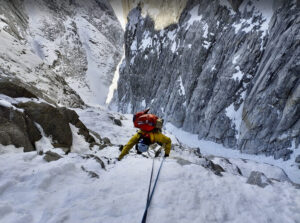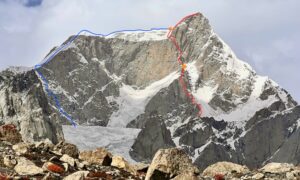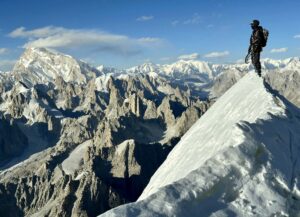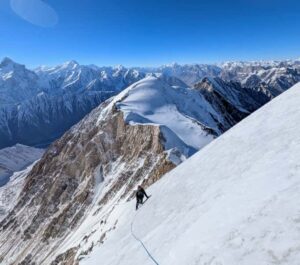Without a doubt, one of the most beautiful mountains in the Karakoram is 7,665m Chogolisa, near the Baltoro Galcier in the Concordia region. Today we will tell about some of the early climbs that took place on this trapezoidal peak.
Twin summits
In Balti, “Chogolisa” means The Great Hunt (Chogo Ling Sa). Chogolisa has two main peak, a 7,665m southwest summit and a slightly lower 7,654m northeast summit. The southwest summit sits along a razor’s edge, while the northeast summit is a 20m high rock formation that is very exposed. The two summits connect via a 914m-long ridge. Avalanches, huge seracs, dangerous ice, and unstable snow cornices are some of the obstacles on the way to the top.
Chogolisa has just over 30 ascents in total.
Two Japanese climbers, led by Takeo Kuwabara, made the first ascent of the northeast summit on August 4, 1958. An Austrian team under Eduard Koblmueller first climbed the southwest summit on August 2, 1975.
First view and first attempt
In 1892, British politician and mountaineer William Martin Conway made an exploratory trip to K2 and first sighted Chogolisa. Its shape, which resembled a bridal veil, impressed him. Since it’s always entirely clad in white, he named it Bride Peak. Its northeast summit continues to be known by that name today.
In 1909, mountaineer and explorer Luigi Amadeo di Savoia, the famed Duke of the Abruzzi, attempted K2. He also tried to climb Chogolisa, and he and his two partners managed to reach 7,498m. Bad weather, poor visibility, and deep snow prevented them from summiting.
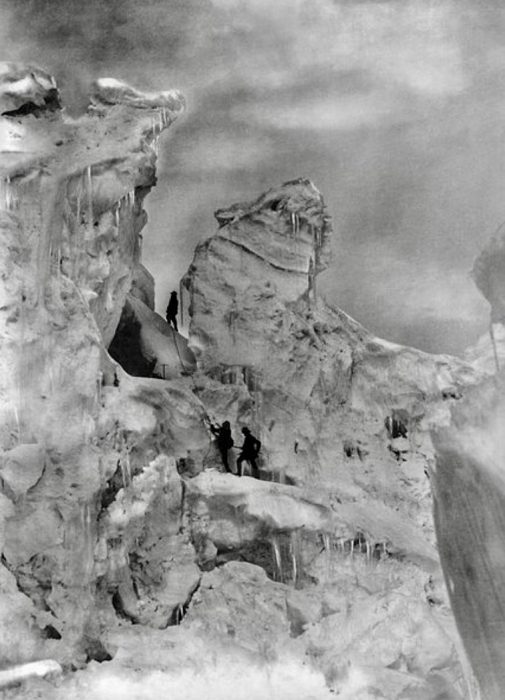
Luigi Amadeo and guides climbing an icefall on Chogolisa in 1909. Photo: Vittorio Sella
1957: A key year in mountaineering history
”Mountaineering is a relentless pursuit. One climbs further and further, yet never reaches the destination. Perhaps that what gives it its own particular charm. One is constantly searching for something never to be found.” — Hermann Buhl
On June 9, 1957, four Austrians, led by Marcus Schmuck, made the first ascent of 8,051m Broad Peak. Among the summiters were Hermanm Buhl, 33, and Kurt Diemberger, 25. Four years earlier, Buhl had made the first ascent of 8,125m Nanga Parbat, as part of a German-Austrian expedition. He was the only one to reach the top.
An alpine-style pioneer on the world’s highest mountains, Buhl was undoubtedly drawn by the beauty of these peaks. Apart from wanting to be the first to summit unclimbed mountains, something else in him, a romantic vision perhaps, drew him to these aesthetic goals.

Hermann Buhl. Photo: Rupal Expeditions
Buhl on Chogolisa
After his successful first ascent of Broad Peak, Buhl had other plans for 1957.
”One mountain, more than any other, had ensnared our imagination during the days of our Broad Peak climb,” Diemberger, Buhl’s partner, wrote later in The Himalayan Journal. “Far away, on the southern rim of the Baltoro, Chogolisa raised her glittering roof. That 7,654m summit was next on our list.”
Buhl and Diemberger decided to attempt Chogolisa in late June of that year. They aimed for the northeast summit via the Baltoro and Chogolisa Glaciers.

The formidable ridge on Chogolisa. Photo: Summitpost
On June 25, they left Camp 1 and camped in a saddle at 6,706m on the southeast ridge. However, two days later, a big storm broke out, forcing them to abort their push at 7,200 to 7,300m.
The wind in Karakoram comes from the west, and cornices form to the east and north. During the descent, Buhl was walking over one such cornice when it broke and triggered an avalanche that carried him 900m over Chogolisa’s North Face. His body was never found. Diemberger descended alone.

Chogolisa from the shoulder of K2. Photo: Wikimedia
The first ascent of the northeast peak
On August 4, 1958, two Japanese climbers from the Academic Alpine Club of Kyoto, led by Takeo Kuwabara, finally made the first ascent of Chogolisa’s northeast peak.
The two summiters, Masao Fujihira and Kazumasa Hirai, used bottled oxygen, although this ran out at midnight during their summit push and they continued without it. They summited at 4:30 pm. From the top, they saw a Brocken Spectre in the mist.

A Brocken Spectre. Photo: Shutterstock
At first they tried to ascend Buhl and Diemberger’s route, but they had to do a small variation on the upper part. The Japanese set their Camp 4 at 6,700m. Here, close to a rock, was Hermann Buhl’s tent.
In the tent, they found Buhl’s sleeping bag, covered with snow and ice, two notebooks, some biscuits, canned sardines, a roll of film, and more. The Japanese had earlier heard that Buhl’s widow wished to recover mementos of her husband, so they took these artifacts and gave them to the Italian team attempting Gasherbrum IV. The Italians later passed them on to Buhl’s widow.
The second ascent of the northeast peak
In 1986, a Spanish party led by Sebastian Alvaro made the second ascent of the northeast peak via a new route up the northeast ridge. On June 22, first Jose Carlos Tamayo and Felix de Pablo summited. Then the following day, Ramon Portilla and Gregorio Ariz also reached the top.
The Japanese doll
There, Portilla found a small doll dressed as a Japanese child. They debated whether to carry it down with them. Either Fujihira or Hirai had left that doll on the summit 28 years before. Thinking that the Japanese might not approve if they took it down, Ariz convinced Portilla to leave the doll in place.

Climbing Chogolisa, 1986. Photo: Sebastian Alvaro
The first ascent of the southwest peak
Austrians Fred Pessl and Gustav Ammerer made the first ascent of the slightly higher southwest summit (7,665m) on August 2, 1975. Eduard Koblmueller was the team leader.
Two days later, two other climbers from this party, Alois Furnter and Hilmar Sturm, also reached the summit.
On July 7, Koblmueller was bypassing an icefall on a heavily corniced ridge when the cornice gave way. He fell 30m, but fortunately another member of the team held him and he was unhurt. But he almost died just as Buhl had.

Chogolisa. The red line shows the ridge that the Spanish team climbed in 1986. Photo: Sebastian Alvaro
The first traverse
In 1986, a few weeks after the Spanish team’s ascent, a British expedition led by Andrew R. Fanshawe succeeded in making the first traverse between the two peaks. Liam Elliot, Hamish Irvine, Ulric Jessop, Simon Lamb, and Fanshawe reached the southwest summit on August 14. They then traversed to the northeast summit.
Liam Elliott died a few weeks later on Broad Peak, falling through a huge cornice at 7,900m on the summit ridge.
As far as we can determine, it remains unknown whether that Japanese doll is still on the northeast summit of Chogolisa.

A Japanese Kimekomi Doll. The term ‘kimekomi’ refers to the clothing, originally created in Kyoto during the early 1700s. Photo: The Strong National Museum of Play via Japanobjects

